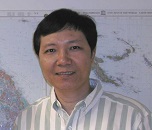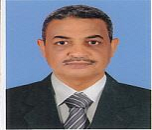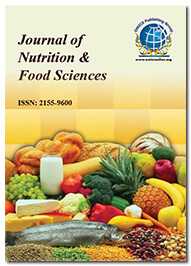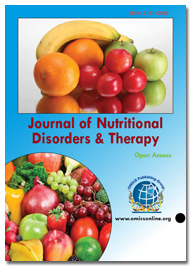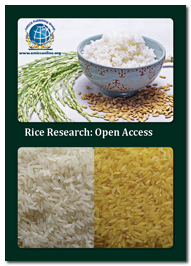Theme: Generating Sustainable Ideas to Feed the Future
Food Security 2016
Global Food Security and Sustainability Conference (Food Security) will be held during September 05-07, 2016 at Beijing, China. Food security is often defined in terms of food availability, food access and food utilization Successful food security and poverty-oriented programmes not only assist poor rural populations to produce more and diversified products but to produce a surplus that can be marketed and thereby generate income for the purposes of improving quality of life through improved diet and nutrition, investment in productive activity, and as collateral for credit to purchase inputs and/or other supplies to enhance agricultural or non-agricultural enterprise.
Track 1: Global Food Security
Attiring global food security and restoring demands on the environment is the greatest challenge faced by mankind. By the time 2050 at least nine Billion people need food, and increasing incomes and urbanization will inevitably lead to dietary revamp. The food security competitiveness will increasingly fringe the triple burden of malnutrition– undernutrition, obesity and deficiencies in micronutrient. The importance of the food security issues has led to huge scientific strides which forwards and making it difficult to keep up with the rapidly expanding value of scientific research and technology. Policies to implement global and local food security needs to be actualize and decision makers should have to make difficult choices to ameliorate the food security of local people against the limelight of drastic global changes.
Related Conferences on Food Security:
International Conference on Global Food Security and Sustainability, September 05-07, 2016 Beijing, China; 5thInternational Conference on Agriculture & Horticulture, June 27-29, 2016 Cape Town, South Africa; International Conference on Plant Physiology, June 09-11, 2016 Dallas, USA; 9th Euro-Global Summit on Food & Beverages, July 11-13, 2016 Cologne, Germany ; 3rd Global Food Safety Conference, September 01- 03, 2016 Atlanta, USA; Nutrition Conferences Europe June 16-18, 2016 Holiday inn Rome- Aurelia, Rome,3rd International Conference on Food Security and Nutrition (ICFSN 2016 March 23-25, 2016, Amsterdam, Netherlands; 18th International Conference on Global Food Security, January 7-8, 2016, Singapore; XIV International Conference on Food Security and Nutrition February 7-8, 2016,New Delhi, India; The Consumer Goods Forum – Global Food Safety Conference February 29 - March 3, 2016 ,Berlin, Germany; 18th International Conference on Global Food Security March 7-8, 2016,Miami, FL.
Related Societies on Food Security:
Alder Food Security Society Canada; Richmond Food Security Society Canada; Asian Food Safety and Security Association, Japan; Committee on World Food Security, Italy; European Food Safety Authority, Italy; Institute of Food Technologists, USA; American Meat Science Association, USA.
Track 2: Science, Sociology and Economics
One by fourth of the people on globe are “food insecure”, means these individuals do not know where their next meal will coming from. As the world population increases to 9 Billion by 2050, it will require a 70% increase in local food production to feed everyone. It is thus challenge to big league companies to collaborate with farmers and communities to convalesce local food security. Food Security is a complex issue that encloses more than just food production although there is no doubt the cornerstone. Thus social and economic sciences must provide an interdisciplinary basis along with the natural sciences (biology, chemistry, food science maths and physics). Regional conditions need to be taken into consideration like weather changes, Elevation, length of the day and soil difference all need to be considered to arrive the best solution for particular area. Such efforts will determine which type of seeds to plant and by improving agricultural practices based on the local environment can help to achieve a positive impact on yield. High yield hybrid seeds can help farmers improve their productivity.
Related Conferences on Science, Sociology and Economics:
International Conference on Social Media, SEO & Marketing Strategies November 03-04, 2015 Valencia,Spain; International Conference on Global Food Security and Sustainability, September 05-07, 2016 Beijing, China;5th International Conference on Biodiversity, March 10-12, 2016 Madrid, Spain; Global Summit and Expo on Fluid Dynamics & Aerodynamics March 07-09, 2016 Madrid, Spain; International Conference on Physics June 27-29, 2016 New Orleans, USA ;Nutrition Conferences Europe June 16-18, 2016 Holiday inn Rome- Aurelia, Rome;4th International Conference on Sustainable Development, ICSD-2016,16- 17 Sep,2016 ,Rome, Italy; International Conference on Self-Adaptive and Self-Organizing Systems,21-25 Sep 2015; Cambridge, United States; Society of Labour Economists (SOLE) Annual Meeting 2016,06 -07 May 2016; Seattle, United States; Wind Energy Symposium,04-08 Jan 2016; San Diego, United States
.Related Societies on Science, Sociology, Economics:
Asian Food Safety and Security Association, Japan. Australian Institute of Food Science and Technology, Australia. Food Industry Students European Council, Netherland. European Food Information Resource, Belgium. European Food Safety Authority, Italy. Institute of Food Technologists, USA. Food Industry Students European Council, Netherland.
Track 3: Aquaculture in Food Security
Fish contributes to the national food self-sufficiency through direct consumption and through trade and exports. Therefore, more attention should be given in production of Aquaculture to secure. In traditional fish eating countries in Asian and Oceania, per capita consumption are more than 25 kg. In some island countries in the Pacific the per capita consumption are more 50 kg per year or even as high as 190 kg as is the case in Maldives. The extreme importance of aqua to food security and nutrition may be illustrated by assessments on the situation in Africa. FAO estimates that fish produce 22 percent of the protein intake in sub-Saharan Africa. This share, however, can exceed 50 percent in poorest countries. Aquaculture can be benefit the livelihoods of the poor either through an improved food supply and/or through employment and increased income and there is a sure benefit of consuming fish, that is the nutritional and health benefit to be gained from its nutritional content. Food fish has a nutrient profile superior to all terrestrial meats. It is excellent source of high quality animal protein and highly digestible energy, In fact, if there is a single food content that could be used to address all the different aspects of world malnutrition, it is fish - the staple animal protein source of traditional fishers.
Related conference to Aquaculture in Food Security:
2nd Global Summit on Aquaculture & Fisheries July 11-13, 2016 Kuala Lumpur, Malaysia; 4th International Conference on Aquaculture & Fisheries September 29-October 01,2016 London, UK ;International Conference on Global Food Security and Sustainability September 05-07, 2016 Beijing, China; 12th International Conference and Exhibition on Food Processing & Technology, October 24-26, 2016 Istanbul, Turkey ; International Conference on Food Preservation & Packaging March 31-April 01,2016 Atlanta, GA, USA ; World Aquaculture Conference meeting 2016 February 22 - 26, 2016 Las Vegas, Nevada ; Asian-Pacific Aquaculture Summit 2016 April 26- 29, 2016 Surabaya, Indonesia; Aquaculture UK 2016, May 25 - 26, 2016, Aviemore , Scotland, UK; ASEAN Fisheries and Aquaculture Conference and Exposition 2016, August 4-6, 2016 , Bangkok Thailand; 7th World Fisheries Congress: Challenge to Sustainable Fisheries and Safe Sea foods June 6-11, 2016 Busan, Korea;Nutrition Conferences Europe June 16-18, 2016 Holiday inn Rome- Aurelia, Rome.
Related Societies on Aquaculture in Food Security:
American Meat Science Association, US; North American Meat Institute, Washington Dc; Specialty Coffee Association of America, USA; Association of Food Science and Technology , Spain; Institute of Food Technologists, USA; European Food Information Resource, Belgium; American Dairy Science Association, Illinois.
Track 4: Environmental Change and Food Security in China
Climate change affects agriculture and food production in complex ways. It affects food production directly through changes in agro-ecological conditions and indirectly by affecting growth and distribution of incomes, amoderate incremental warming in some humid and temperate grasslands may increase pasture productivity and reduce the need for housing and for compound feed. These gains have to increase in atmospheric carbon dioxide (CO2) concentrations. Finally, a number of recent studies h be set against an increased frequency of extreme events. Another important change for agriculture is tave estimated the likely changes in land suitability, potential yields, and agricultural production on the current suite of crops and cultivars available today. Global and regional weather conditions are also expected to become more variable than at present, with increases in the frequency and severity of extreme events such as cyclones, floods, hailstorms, and droughts. The main concern about climate change and food security is that changing climatic conditions can initiate a vicious circle where infectious disease causes or compounds hunger, which, in turn, makes the affected populations more susceptible to infectious disease. Essentially all manifestations of climate change, be they drought, higher temperatures, or heavy rainfalls have an impact on the disease pressure, and there is growing evidence that these changes affect food safety and food security.
Related Conferences on Environmental Change:
5th International Conference on Biodiversity, Nutrition Conferences Europe June 16-18, 2016 Holiday inn Rome- Aurelia, Rome. March 10-12, 2016 Madrid, Spain; International Conference on Pollution Control& Sustainable Environment, April 25-26, 2016 Dubai, UAE International Conference on Coastal Zone Management, May 16-18, 2016 Osaka, Japan; 5th International Conference on Earth Science & Climate Change, July 25-27, 2016 Bangkok, Thailand; 3rd World Congress & Expo on Recycling Oct 06-07, 2016 Miami, USA ; 8th International Conference on Climate Change: Impacts and Responses, April 21-22 2016 ,Vietnam; Bird Conservation in the Face of Future Climate Change, , Sep 10, 2015,USA; United States;18th International Conference on Climate Change Technology, June 1-2,2016, Dubai; EcoSummit 2016, 29 Aug-1 Sep,2016, Montpellier, France. The Fourth International Climate Change Adaptation Conference, May 10 -13 2016, Rotterdam, the Netherlands.
Related Societies on Environmental change:
Climate Change, Agriculture and Food Security Society, Ireland. The Association of Food Technology, Turkey. American Oil Chemists' Society, Illinois. American Meat Science Association, USA. Dairy Industry Association of Australia, Australia. European Federation of Food Science and Technology, Netherland.
Track 5: Hybridization and Its Effect
In agriculture and animal husbandry, the Green Revolution popularized the use of conventional hybridization to increase yield by creating "high-yielding varieties" for example hybrid rice. The handful of hybridized breeds originated in developed countries and were further hybridized with local varieties in the rest of the developing world to create high yield strains resistant to local climate and diseases.. According to the International Service for the Acquisition of Agri-biotech Applications (ISAAA), genetically engineered crops were grown by approximately 8.5 million farmers in 21 countries in 2005; up from 8.25 million farmers in 17 countries in 2004.The main objective of research and development for food security is to find improved seed varieties, that enable reliable high yields at the same or lower tillage costs through qualities such as resistance to or tolerance of plant diseases and animal pests as well as to stress factors such as climatic variation or aridity, poor soil quality, crop rotation practices, and others. Equally important objectives are the transfer of genes with nitrogen-fixing capacity on to grains, and the improvement of food quality by overcoming vitamin or mineral deficiencies. The realization of these objectives will bring tremendous benefits – benefits that can easily be demonstrated using rice (the staple food for 2.4 billion people) and cassava (the staple food for 500 million people)
Related Conferences on Hybridization and Food Security:
International Conference on Global Food Security and Sustainability, September 05-07, 2016 Beijing, China; 5th International Conference on Agriculture & Horticulture, June 27-29, 2016 Cape Town, South Africa; International Conference on Food Preservation & Packaging March 31-April 01, 2016 Atlanta, USA ; 2nd International Conference on Food Safety and Regulatory Measures June 06-08, 2016 London, UK ; International Conference on Plant Physiology, June 09-11,2016 Dallas, USA; Nutrition Conferences Europe June 16-18, 2016 Holiday inn Rome- Aurelia, Rome, BIOTECH 2016, June 6-9, 2016 San Francisco, California; 4th International Conference on Food Oral Processing, Plant Epigenetics: From Genotype to Phenotype, 03-06 Jul 2016,Lausanne, Switzerland; National Seed Science Forum, 15-16 March 2016,Australia, XIV International Symposium on Processing Tomato. March 6-9, 2016 ,Santiago (Chile).
Related Societies on Hybridization and Food Security:
Australian Institute of Food Science and Technology, Australia; American Meat Science Association, USA; Dairy Industry Association of Australia, Australia; Richmond Food Security Society Canada; American Cheese Society, USA; Chinese American Food Society, USA; The Food and Beverage Export Association, Italy; International Association of Engineering and Food, USA.
Track 6: Sustainable Food Production Systems
In an era of scarcity it is becoming increasingly important to address production and consumption jointly because of the linkages between the two. The transition to a more sustainable food chain cannot be met by concentrating on approaches aiming only at productivity increases - the possibilities of sufficiency oriented research have to be explored as well. There should be open opportunities for transition to sustainable and equitable food systems through a systemic approach founded on a better understanding of socio-ecological systems. So far the focus of research and policy has been on the supply-side by providing technological innovations, however social innovations in the domain of production are as important as technological ones. It is equally important to address demand-side issues, and to reduce the present unsustainable levels of consumption. Therefore, research on behavioural or structural changes in food systems, food processing and supply chains should be given a higher priority.
Related Conferences on Food Production:
International Conference on Food Chemistry and Hydrocolloids August 04-05, 2016 Toronto, Canada ; 9th Euro-Global Summit & Expo on Food & Beverages, July 11-13, 2016 Cologne, Germany; 13th Global Food Manufacturing Conference, October 20-22, 2016 Kuala Lumpur, Malaysia; 12th International Conference and Exhibition on Food Processing & Technology, October 24-26, 2016 Istanbul, Turkey; International Conference on Food Preservation & Packaging, March 31-April 01, 2016 Atlanta, GA, USA; 2nd International Interdisciplinary Conference on LAND USE and WATER QUALITY: Agricultural Production and the Environment, 21-24 sep,2015, Vienna, Austria; 4th African Food and Nutrition Forum: "Global response for sustainable food systems in the post-Millennium Development Goal Era",27–29 October 2015 ,Addis Ababa, Ethiopia;Nutrition Conferences Europe June 16-18, 2016 Holiday inn Rome- Aurelia, Rome.
Related Societies on Food Production:
International Association of Engineering and Food,USA; The Food and Beverage Export Association, Italy; Australian Institute of Food Science and Technology, Australia; Richmond Food Security Society , Canada; American Cheese Society, USA; Warwick Good Food Society, UK.
Track 7: Urbanization and Food value chains
As cities expand, so do the food needs of urban families. The situation of the urban poor is precarious in the present condition of volatile food prices and the financial, fuel and economic crises. The urban poor, often located in the most vulnerable parts of cities and lacking the capacity to adapt to climate-related impacts, will be hit hardest. The challenges associated with supporting the urban poor demand urgent and adequate responses from city and national authorities and international organisations. Urban policies need to incorporate food security considerations and focus more on building cities that are more resilient to crises. Metropolitan, municipal and other local government institutions can play a proactive and coordinating role in enhancing urban food security. Developing local value chains for food and nutrition security is an important task. It focuses efforts on strengthening capacities of local food producers and business to supply more food to domestic and tourist markets to meet demands for a balanced and nutritious diet and to reduce food and feed imports.
Related Conferences on Urbanization, Food Value Chains:
4th International Conference and Exhibition on Nutrition August 18-20,2016, London, UK ; 12th International Conference and Exhibition on Food Processing & Technology, October 24-26, 2016 Istanbul, Turkey ; International Conference on Food Preservation & Packaging March 31-April 01, 2016 Atlanta, GA, USA ; 9th Euro-Global Summit & Expo on Food & Beverages, July 11-13, 2016 Cologne, Germany; 13th Global Food Manufacturing Conference , October 20-22, 2016 Kuala Lumpur, Malaysia ; Nutrition Conferences Europe June 16-18, 2016 Holiday inn Rome- Aurelia, Rome.16th International Conference Rural-Urban Symbiosis, September 8-10, 2016, Hamburg, Germany; 13th International Asian Urbanization Conference January 6-8,2016,Indonesia; 18th International Conference on Urban Regeneration and Sustainability, January 21 - 22, 2016, Paris,France; 18th International Conference on Environment and Urbanization, January 12 - 13, 2016, Johannesburg,South Africa; 3rd International Conference on Design, Construction. Jun 27, 2016 - Jun 29, 2016,San Servolo, Italy;
Related Societies on Urbanization, Food Value Chains:
Chinese American Food Society, USA; ISEKI-food Association, Austria; World Public Health Nutrition Association United Kingdom; North American Meat Institute, Washington Dc; Specialty Coffee Association of America, USA; Warwick Good Food Society, UK; Food Industry Students European Council, Netherland; Australian Institute of Food Science and Technology, Australia.
Track 8: Consumer Behaviour, and Nutritional Security
Food security is presently being undermined by a number of challenges such as rapidly growing demand and changes in consumption patterns. The 2007–2008 world food crisis tested the resilience of the global food system and revealed deficiencies in its capacity to efficiently adjust to and absorb shocks that show many signs of growing in the future. If consumers actually do modify their food preferences, the factors that push consumers towards this modification, how consumers overcome this changing vulnerability, if this vulnerability exposes these households to food insecurity and finally to explore adaptation strategies at both individual, household and societal levels. On the other hand Food and nutrition security is about ensuring that everybody is able to access sufficient, affordable and nutritious food. Therefore to build resilience to food crises and help countries ensure that no one is left hungry. In particular, fighting under-nutrition is vital to give the world's poorest children a chance to lead healthier lives, learn better and improve their future income opportunities.
Related Conferences on consumer Behaviour, Nutrition Security:
4th International Conference and Exhibition on Nutrition, August 18-20, 2016 London, UK; 3rd Global Food Safety Conference, September 01- 03, 2016 Atlanta, USA; International Conference on Global Food Security and Sustainability, September 05-07, 2016 Beijing, China; International Conference on Food Microbiology, August 08-10, 2016 Birmingham, Nutrition Conferences Europe June 16-18, 2016 Holiday inn Rome- Aurelia, Rome. UK; 5th International Conference on Clinical Nutrition, November 28-30, 2016 San Antonio, USA; 18th International Conference on Food Security and Nutrition,18th International Conference on Nutrition and Food Sciences, July 21 - 22, 2016 Zurich, Switzerland; 18th International Conference on Human Nutrition and Food Sciences, September 15-16, 2016 Rome, Italy; International Conference on Pulses for Nutritional Security and Agricultural Sustainability, February 13, 2016, New Delhi, India; 18th International Conference on Marketing Management February 15 - 16, 2016, Barcelona, Spain;
Related Societies on consumer Behaviour, Nutrition Security:
The Association of Food Technology, Turkey; Association of Food Science and Technology, Spain; Institute of Food Technologists, USA; Specialty Coffee Association of America, USA; Australian Institute of Food Science and Technology, Australia; Food Industry Students European Council, Netherland.
Trade Liberalization is the removal or reduction of restrictions or barriers on the free exchange of goods between nations. This includes the removal or reduction of both tariff and non-tariff obstacles (like licensing rules, quotas and other requirements). The easing or eradication of these restrictions is often referred to as promoting "free trade." Policies for liberalization in trade that make an economy open to trade and investment with the rest of the world are needed for sustained economic growth. The evidence on this is clear. No country in recent decades has achieved economic success, in terms of substantial increases in living standards for its people, without being open to the rest of the world. In contrast, trade opening (along with opening to foreign direct investment) has been an important element in the economic success of East Asia, where the average import tariff has fallen from 30 percent to 10 percent over the past 20 years. The best approach would be to identify the major sources of income of the poor and ask how liberalization would impact these sources. For a large chunk of the poor population, the principal source of income is labour, and technology the question is how liberalization will impact the real wage. Some of the poor may own small amounts of land, and thus earn a part of their income from producing and selling agricultural products. In this case, how the profitability of what they produce is impacted must be taken into account.
Related Conferences on Trade Liberalization:
International Conference on Global Food Security and Sustainability, September 05-07, 2016, Beijing, China; 12th International Conference and Exhibition on Food Processing & Technology, October 24-26, 2016 Istanbul, Turkey; 4th International Conference and Exhibition on Nutrition, August 18-20,2016, London, UK; 5thInternational Conference on Agriculture & Horticulture ,June 27-29, 2016 Cape Town, South Africa 9th Euro-Global Summit & Expo on Food & Beverages, July 11-13, 2016 Cologne, Germany; UNCTAD: The United Nations Conference on Trade and Development, Preliminary Program Of The Allied Social Science Associations, January 3-5, 2016, San Francisco, CA; Nutrition Conferences Europe June 16-18, 2016 Holiday inn Rome- Aurelia, Rome EU Trade Policy Conference, February 4–6, 2016, Vienna, Austria; 6th International Conference on Economics Trade and Development, Mar 20-21,2016, Amsterdam, Netherlands; 2nd Energy Market Liberalization Expo, March 2-4, 2016, Tokyo, Japan.
Related Societies on Trade Liberalization:
American Dairy Science Association, Illinois; Food Industry Students European Council, Netherland; Specialty Coffee Association of America, USA; Australian Institute of Food Science and Technology, Australia; Institute of Food Technologists, USA; American Oil Chemists' Society, Illinois.
Track 10: Biofuels :Importance in Food Security
Next Generation Biofuel demand is increasing because of a combination of growing energy needs; rising oil costs; the pursuit of clean, renewable sources of energy; and the desire to boost farm incomes in developed countries. In turn, the need for crops-such as maize and sugarcane-to be used as feedstocks for biofuels has increased dramatically. That demand has had a significant and increasing impact on global food systems. The effects of growing biofuel demand are interwoven with tightening grain markets, which reflect demographic shifts and improved diets. In developing countries, as populations grow and incomes rise, diet preferences are shifting from staple crops to higher-value products like meat and dairy. As a result, the demand for grain-and protein-based animal feed is soaring and competing with food needs. These changes have led to increasing pressures on global agricultural markets and higher food costs. Poor people in both rural and urban areas are disproportionately vulnerable to these forces because they spend a large share of their incomes on food. Biofuels subsidies in developed countries tend to drive up food prices, thus reducing consumption and nutritional well-being for net buyers.
Related Conferences on Biofuels:
International Conference and Expo on Oil and Gas , November 10-12, 2016; 9th Euro-Global Summit & Expo on Food & Beverages, July 11-13, 2016 Cologne, Germany; 3rd World Congress & Expo on Recycling, July 25-27, 2016, Berlin, German ; International Conference on Green Energy & Expo,5th International Conference on Earth Science & Climate Change , July 25-27, 2016 Bangkok, Thailand; Biomass for Sustainable Future: Re-Invention of Polymeric Materials, February 9-11,2016 Las Vegas, USA; Global Forum for Innovations in Agriculture, February 16-17, Abu Dhabi; ARPA-E 2016 Energy Innovation Summit, February 22-24, 2016,USA; 5th Annual International Conference on Sustainable Energy and Environmental Sciences, February 22-23,2016,Singapore; International Biomass Conference & Expo, April 11-14. 2016, North Carolina, USA; 4th USA Science & Engineering Festival. April 16-17, 2016, Washington, USA; Nutrition Conferences Europe June 16-18, 2016 Holiday inn Rome- Aurelia, Rome.
Related Societies on Biofuels:
Chinese American Food Society, USA; The Food and Beverage Export Association, Italy; ISEKI-food Association, Austria; National Association of Citrus Juice Processors, Florida; American Cheese Society, USA; The Association of Food Technology, Turkey; European Food Safety Authority, Italy; Specialty Coffee Association of America, USA; European Federation of Food Science and Technology, Netherland.
Track 11: Genetically Modified Crops : Solution to Global Food Security
The introduction of the first transgenic plant 30 years ago heralded the start of a second green revolution, providing food to the starving, profits to farmers and environmental benefits to boot. Many GM crops fulfilled the promise. But their success has been mired in controversy with many questioning their safety, their profitability and their green credentials. They are plants used in agriculture, the DNA of which has been modified using genetic engineering techniques. In most cases the aim is to introduce a new trait to the plant which does not occur naturally in the species. Examples in food crops include resistance to certain pests, diseases, or environmental conditions, reduction of spoilage, or resistance to chemical treatments or improving the nutrient profile of the crop. Examples in non-food crops include production of pharmaceutical agents, biofuels, and other industrially useful goods, as well as for bioremediation. Farmers have widely adopted GM technology. Between 1996 and 2013, the total surface area of land cultivated with GM crops increased by a factor of 100, from 17,000 square kilometers ( to 1,750,000 square kms. 10% of the world's croplands were planted with GM crops in 2010. In the US, by 2014, 94% of the planted area of soybeans, 96% of cotton and 93% of corn were genetically modified varieties.In recent years commercialization of GM crops expanded rapidly in developing countries. In 2013 approximately 18 million farmers grew 54% of worldwide GM crops in developing countries.
Related Conferences on GM Crops:
International Conference on Green Energy & Expo ; 5th International Conference on Agriculture & Horticulture, June 27-29, 2016 Cape Town, South Africa; Nutrition Conferences Europe June 16-18, 2016 Holiday inn Rome- Aurelia, Rome. International Conference on Plant Physiology, June 09-11, 2016 Dallas, USA ;International Conference on Global Food Security and Sustainability, September 05-07, 2016, Beijing, China; 9th Euro-Global Summit & Expo on Food & Beverages, July 11-13, 2016 Cologne, Germany; International Conference on Food Microbiology, August 08-10, 2016 Birmingham, UK; Global Biotechnology Congress 2016, May 11th - 14th 2016, Boston, USA; 7th International Crop Science Congress, August 14–19, 2016, Beijing China; 7th China International Fertilizer Show, 9-11, March, 2016 in Shanghai, China; Annual International Congress of Genetics– 2016, April 25-28, 2016 ,Dalian, China; 7th International Conference on Coexistence between Genetically Modified (GM) and non-GM based Agricultural Supply Chains. November 17 - 20 2016, Netherlands, Amsterdam;
Related Societies on GM Crops:
American Dairy Science Association, Illinois; American Meat Science Association, USA; European Food Information Resource, Belgium; Dairy Industry Association of Australia, Australia; Food Industry Students European Council, Netherland; Warwick Good Food Society, UK; Specialty Coffee Association of America, US; Australian Institute of Food Science and Technology, Australia
Track 12: Entrepreneurs Investment Meet
In support of sustainable entrepreneurship goals, business ideas can address improvements to the enabling environment, for example legislative and regulatory improvements, or tackle supply chain related infrastructure constraints. Proposals in Food Security 2016 can also focus on improving access to finance, capacity building through enhanced knowledge and skills, and enable greater access to markets.
From a food security perspective, business ideas should identify ways to sustainably increase food production, enable greater access to healthy food, ensure markets function more efficiently and generate improvements in the overall business climate.
ConferenceSeries Ltd with immense pleasure invites all the contributors across the globe to the Global Food Security and Sustainability (Food Security 2016) during September 05-07, 2016 at Beijing, China which includes prompt keynote presentations, Oral talks, Poster presentations and Exhibitions.
ConferenceSeries Ltd organizes 1000+ scientific events inclusive of 600+ Conferences, 500+ Workshops and 200+ Symposiums on various topics of Science & Technology across the globe with support from 1000 more scientific societies and Publishes 500+ Open Access journals which contains over 50000 eminent personalities, reputed scientists as editorial board members.
Food security is often defined in terms of food availability, food access and food utilization. Global agriculture currently produces ample calories and nutrients to provide the entire world's people healthy and productive lives". However, food is not distributed equally to regions, countries, households and individuals. Improved access to food-through increased agricultural productivity and incomes-is essential to meet the food needs of the world's growing population. Successful food security and poverty-oriented programmes not only assist poor rural populations to produce more and diversified products but to produce a surplus that can be marketed and thereby generate income for the purposes of improving quality of life through improved diet and nutrition, investment in productive activity, and as collateral for credit to purchase inputs and/or other supplies to enhance agricultural or non-agricultural enterprise. Agricultural economists have maintained that greater concentration on small farmers leads to faster growth rates of both aggregate economic output and employment .Other analysts argue that production-focused service delivery directed solely at the poor as producers in isolated areas will yield low and probably diminishing returns.
Beijing is the capital of the People's Republic of China and one of the most populous cities in the world. The population as of 2013 was 21,150,000. Beijing is the second largest Chinese city by urban population after Shanghai and is the nation's political, cultural, and educational centre. It is home to the headquarters of most of China's largest state-owned companies, and is a major hub for the national highway, expressway, railway, and high-speed rail networks. China’s massive capital has history stretching back 3 millennia. Yet it’s known as much for its modern architecture as its ancient sites such as the grand Forbidden City complex, the imperial palace during the Ming and Qing dynasties. Nearby, the massive Tiananmen Square pedestrian plaza is site of Mao Zedong’s mausoleum and the National Museum of China, displaying a vast collection of cultural relics. There are many landmarks in Beijing. The best-known ones include the Badaling stretch of the Great Wall of China, the Temple of Heaven, and the Tiananmen, a number of temples, hutongs and parks.
Join us at Global Food Security conference for “Generating Sustainable Ideas to Feed the Future”. This event has been designed to address scientists, scholars, and different societies supporting food security, Industries and other related scientific communities with different levels of awareness, expertise and proactive solutions to create global impact in this field. Moreover, it will help industrialists to incorporate sustainability into every aspect of Agricultural Industries business model. The Food Security conference will influence industries to maximize their yield and profit through the application of strategic techniques. Additionally, it will reveal the best techniques to promote sustainable agricultural development and achieve a hunger free world by 2050.
Food for all is a fundamental human right, upon which all other human rights depend. China has a bitter memory of hunger and wants to see a world free from hunger and poverty. On the other hand China has announced a $50 million donation to FAO in 2014 to improve food security .China saw a bumper harvest for the 10th consecutive year in 2013 and summer grain output hit a record high of 136.6 million tons in 2014. According to FAO data, grain production in China has increased by 1.04 tons per hectare in the past decade. The country has used 9 percent of global arable land and 6.5 percent of fresh water resources to produce one-fourth of the world’s grain and fed nearly one-fifth of the world’s population. The country has already achieved the 1st Millennium Development Goal's hunger target of halving the proportion of its population experiencing chronic hunger, ahead of the 2015 deadline. Since 1990, China has successfully lifted 138 million people out of chronic hunger. This means that globally, two out of every three people who escaped hunger since 1990 were in China.
We look forward to an exciting scientific event in the beautiful city of Beijing, China.
Introduction to Food security
Global agriculture currently produces ample calories and nutrients to provide the entire world's people healthy and productive lives". However, food is not distributed equally to regions, countries, households and individuals. Improved access to food-through increased agricultural productivity and incomes-is essential to meet the food needs of the world's growing population. Food security is often defined in terms of food availability, food access and food utilization (USAID 1995). Food availability is achieved when sufficient quantities of food are consistently available to all individuals within a country. Food access is ensured when households and all individuals within them have adequate resources to obtain appropriate food for a nutritional diet. Food utilization is the proper biological use of food, requiring a diet providing sufficient energy and essential nutrients, potable water, and adequate sanitation. Successful food security and poverty-oriented programmes not only assist poor rural populations to produce more and diversified products but to produce a surplus that can be marketed and thereby generate income for the purposes of improving quality of life through improved diet and nutrition, investment in productive activity, and as collateral for credit to purchase inputs and/or other supplies to enhance agricultural or non-agricultural enterprise. Agricultural economists have maintained that greater concentration on small farmers leads to faster growth rates of both aggregate economic output and employment .Other analysts argue that production-focused service delivery directed solely at the poor as producers in isolated areas will yield low and probably diminishing returns.
Why to Attend Food Security 2016?
Food Security 2016 has been designed to address scientists, scholars, and different societies supporting food security, Industries and other related scientific communities with different levels of awareness, expertise and proactive solutions to create global impact in this field. Moreover, it will help industrialists to incorporate sustainability into every aspect of Agricultural Industries business model. The Food Security conference will influence industries to maximize their yield and profit through the application of strategic techniques. Additionally, it will reveal the best techniques to promote sustainable agricultural development and achieve a hunger free world by 2050.
State of Food Insecurity in Asia and the Pacific:

During the past quarter century, of all regions in the world, the Asia and the Pacific region has achieved the fastest rate of economic growth. This has led to a dramatic reduction in extreme poverty below US$ 1.25/person/day measured at 2005 international prices, adjusted for PPP.
The region met the Millennium Development Goal of reducing the proportion of people living in extreme poverty by half in early 2010, well before the MDG target date. The region also achieved the largest reduction in the number of undernourished people in the world. As a consequence, owing to the concerted efforts by all concerned, the region achieved the MDG 1c target of reducing the proportion of people who suffer from hunger by half by 2015.
We should be proud of this remarkable and historic achievement, which has been a longstanding dream. However, there are large disparities among sub regions and countries in achieving the target, and there still remains 12 percent of the region’s total population who have been left behind and have not shared fully in the benefits of economic growth. Without supporting them, we cannot achieve ‘Zero Hunger’ in the region. The world now produces enough food to feed everyone.
World cereal production in 2014 is estimated at 2 544 million tonnes, 51 million tonnes more than the required quantity. Based on the current forecast for cereal stocks and utilization, the cereal stocks to-use ratio is expected to reach 25.9 percent in 2014/15, its highest value since 2001/02. Meanwhile, world food prices are low. The FAO Food Price Index averaged 173.8 points in March 2015, down nearly 40 points (18.7 percent) below its level in March 2014. Lower food prices are good for consumers in general, and also for many small farmers who are net buyers of food. The FAO estimates that in the past 25 years, the average dietary energy supply adequacy increased significantly, and almost all countries in the region now have adequate food supplies to meet people’s average dietary needs.
However, FAO estimates that globally a total of 795 million people do not have access to a sufficient supply of dietary energy to live a healthy life, with 490 million – nearly two thirds of the total – living in the Asia and the Pacific region. These disadvantaged people live at the bottom of society, suffering daily extreme hardship. Until hunger is completely eradicated, social equity and sustainable development will not be achieved. FAO is therefore focused on helping these hundreds of millions of people through the Zero Hunger This regional overview has been prepared to take stock of the current food security situation, present the challenges of ensuring food security in the context of growing and changing patterns of food demand, and propose key measures that must be taken in a coordinated manner by different stakeholders in this very dynamic and populous part of the world. It is therefore suggested to work together with its member countries and partners around the region and the globe towards eradicating hunger, ensuring future generations of farmers and consumers are well nourished and prosperous, and achieving a world with equity, peace, stability and sustainable development.
Why China?
China remains home to the second largest population of undernourished people in the world (160 million or about 11 percent of the country's population). Besides, a large number of people in China suffer from lack of micronutrients in their diet, the so-called hidden hunger. Striking an efficient balance between grain self-sufficiency and food security is thus important to get on the road to food security.
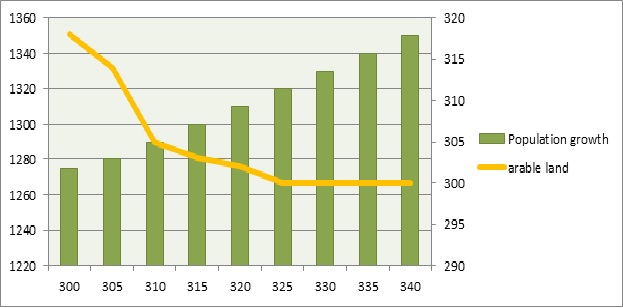
China's food security is being challenged by a mix of factors, including rising demand, rapid urbanization, scarce natural resources and agricultural labour, and greater risk of food safety and environmental problems.
To address food security concerns, China had resolved to meet the bulk of its grain demand domestically. But this policy is now being revisited, suggesting a considerable increase in the already rising food imports. Though it deserves the highest priority, food security does not equal grain self-sufficiency.
The extent of China's grain sufficiency will be somewhat relaxed and the import structure optimized. Such a policy will allow China to make better use of the international market vis-a-vis the advantages of the country's agriculture sector. It will also facilitate improved allocation of resources among different commodities. China can help the regional and global markets. Stable domestic grain supply can help China reduce volatility in the global markets, because the country accounts for a large share of rice and wheat production and consumption and any swing in its imports/exports will have a significant impact on global rice and wheat price
Key Factors regarding China’s Export Market:
Exports in China increased to 1950.97 USD Hundred Million in July from 1920.11 USD Hundred Million in June of 2015.
Exports in China averaged 527.47 USD Hundred Million from 1983 until 2015, reaching an all-time high of 2275.13 USD Hundred Million in December of 2014 and a record low of 13 USD Hundred Million in January of 1984.
Export growth has been a major component supporting China's rapid economic expansion. Exports of goods and services constitute 30% of GDP.
China major exports are: electromechanical products (57 percent of total exports) and labour-intensive products like clothing, textiles, footwear, furniture, plastic products, bags and toys (20 percent).
In recent years, the exports of high tech products have been also growing and in 2012 accounted for 29 percent of total exports. China’s main export partners are the United States (17 percent), European Union (16 percent), ASEAN (10 percent), Japan (7 percent) and South Korea.
The Chinese Government thus designed and implemented reform policies to stimulate village and township enterprises, improve rural and agricultural economic structures and to close the technological gap of agriculture and food production. As a result, China’s agricultural and rural economy has grown hugely in the past 30 years and China is now the largest producer of grain, cotton, fruit, meat, poultry, egg and aquatic product. It is now also the world’s primary producer and consumer of pesticides - which is a cause for pride and concern.
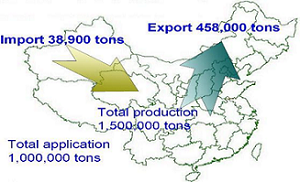
Chinese Agricultural and Food Policy:
That policy is first and foremost a steadfast agricultural support policy, thus aimed to the 320 million Chinese farmers. China’s budget earmarked for agriculture amounts to €90 billion
Providing farmers with strong transparency regarding agricultural activities through price support is indeed at the core of that policy. Consequently, the Government guarantees Chinese farmers grain purchase prices (wheat, corn and rice) up to €250/ton. It is interesting to note that this price is close to the price more or less corresponding to the average cost price (approximately US$200) of a ton of wheat in the U.S., in Canada or in Australia.
Beyond investing in infrastructures and logistics, China strove to improve yields. On the whole, grain production has doubled during the past 15 years, due to the creation of hybrid rice.
China vastly improved its food security, to the point of almost achieving self-sufficiency––95 percent of its needs.
China’s agricultural priorities for the 2010-20 decade are equally meaningful, since they are imbued with both wisdom and determination:
- Maintaining the nation’s self-sufficiency level for key grain crops, in spite of consumption increases;
- Preserving security stock levels above the global average regarding key grain crops (25 percent
- Pursuing investment in logistics infrastructures (including targeting hydraulic equipment) and in production (including mechanization support and fertilizer purchases)
- Emphasizing yield improvements through research programs that are regularly increased (currently over two percent of GDP).

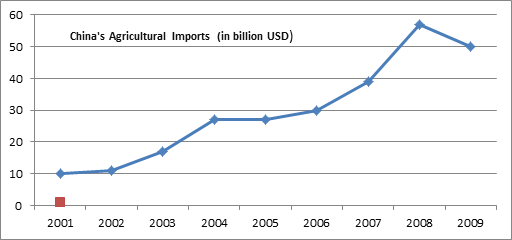
2008: China is now the world’s primary producer and consumer of pesticides - which is a cause for pride and concern. (Data Source for map: China's Ministry of Agriculture)
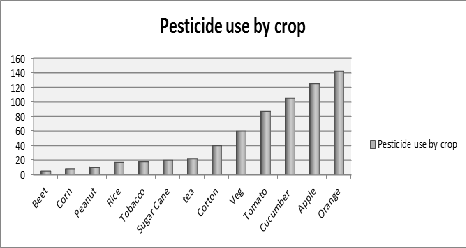
400 million small farmers in China together comprise the largest of the three management patterns in Chinese Agriculture of:
- household farm,
- small-scaled agricultural co-operation organization
- national farm
Agriculture and Food related Organizations in China:
Ø Chinese Farmers Sports Association
Ø China Agricultural Exhibition Association
Ø China Council for the Promotion of Rural Community Development
Ø Chinese Research Association for Agricultural Economic Laws
Ø China Green Food Association
Ø China Agri-produce Marketing Association
Ø Chinese Foundation for Agricultural Science and Education
Ø China Biogas Society
Ø China Society for Agricultural Biotechnology
Ø China Research Association for Agricultural Technology Management
Ø China Association for Agri-ecological Environment Protection
Ø China Animal Agriculture Association
Ø China Association for Plant Nutrition and Fertilizers
Ø China Vegetable Association
Ø Chinese Veterinary Medical Association
Ø China Animal Agriculture Association
Ø China Ikebana and Floriculture Association
Ø China Agricultural Economics Society
Ø China Association for International Exchange of Agriculture Science and Technology
Ø China Society for Agricultural Biotechnology
Ø Chinese American Food Society (CAFS)
Agricultural Universities in China:
· Agricultural University of Hebei
· Yangzhou University
· South China Agricultural University
· Sichuan Agricultural University
· Shandong Agricultural University
· Huazhong Agricultural University
· Northwest Agriculture and Forestry University
· Zhejiang University
· Nanjing Agricultural University
· China Agricultural University
· Beijing University of Agriculture
· Anhui Agricultural University
· Central South University of Forestry & Technology
· Fujian Agriculture and Forestry University
· Graduate University of the Chinese Academy of Sciences
· Nanjing Forestry University
· Northeast Agricultural University
· Qingdao Agricultural UniversityWorldwide Scenario
The World in 2030:
- 7.5â€8 billion people
- Temperature increase by1 degree
- Energy consumption is projected to be 50% higher
- Water demand is projected to be 50% higher
- Little wilderness, new diseases....
- Competition for land will increase....
- Food demand is projected to increase by 40%
Initiatives worldwide to promote food security
Ø The government of South Africa decided in 2002 to initiate a nationwide Integrated Food Security Strategy (South Africa 2002).
Ø The government of Brazil has set itself the goal of eradicating hunger within four years through its Programme Fome Zero (Zero Hunger Programme).
Ø Tanzania has extended the Special Programme for Food Security, providing technical opportunities for improving the output of small farms and raising the incomes of rural families (Tanzania 2002).
Ø Honduras, Kenya, Nicaragua, Pakistan, and Venezuela have also started to forge partnerships with other sectors of society to promote extension and foster conditions to end hunger.
Ø Some national governments have begun to ensure local governments possess the resources and authority to confront hunger and poverty.
Ø Numerous countries in Latin America have moved toward decentralization, including privatization, of their extension systems since the 1980s (Berdegu 2002) and more recently toward poverty reduction (Berdegu and Escobar 2001)
The controversy around food crisis:
Ø IMF World Economic Outlook 17 October 2007 Warns against effect of biofuel
Ø UN Rapporteur on the Right to Food 26 October 2007 "Crime against humanity"
Ø FAO Environment Assessment and Management Unit 1 November 2007 Ziegler’s remark regrettable
Ø JRC Report leakage 18 January 2008 Contribution of +4% for cereals and
+24% for vegetable oil
Ø Nestle CEO 24 March 2008 "Threat for food security"
Ø European Environment Agency 10 April 2008 Ask for suspension of EU biofuel mandate
Ø UN Secretary 14 April 2008 Call for a review of biofuel policies
Ø IMF Chief Economist 14 April 2008 Contribution of 20 to 30 %
Ø UN Rapporteur on the Right to Food 14 April 2008 "Crime against humanity"
Ø US White House 29 April 2008 Contribution of 15%
Ø White House Council of Economic Advisor 1st May 2008 Contribution of 2â€3%
Ø USDA Chief Economist 21 May 2008 Contribution of 10%
Ø US Secretary of agriculture 4 June 2008 Contribution of 2â€3%
Ø Oxfam: "Another Inconvenient Truth" Report 25 June 2008 Contribution of 30%
Ø World Bank "secret report" 3 July 2008 Contribution of 75%
Ø OECD Report 16 July 2008 Contribution of: 5% for wheat 7% for corn, 19% for vegoil
Globally, almost 9 billion ha are currently in use as agricultural land or forest. 43% of this is forest area, of which about 3.5% is forest plantation. 38% is in use as permanent meadows and pastures. The remainder, is in use as arable land or for permanent crops The share of fallow land is only small In the long run, food security depends on natural resources and sustainable innovations. Sustainable land and soil management is a crucial natural resource base which has been neglected over the years. There has been a long-standing research focus on soil and land, particularly in Central Asia and Africa. Recently, research on the economics of land degradation took place . Land prices have risen increasingly worldâ€wide due to increased land scarcity and raising output prices that stimulate demand for land resources. These changes have far-reaching impacts on land rights and institutions. Moreover, poor land users tend to lose out in the competition. These questions have to be addressed.
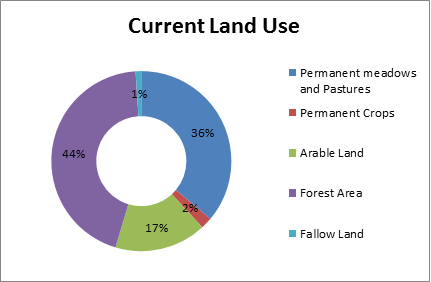
The recent trends in these land areas are Between 1995 and 2005 3
• Global forest area was reduced (80 Mha).
• Arable land increased (24 Mha).
• The area used for permanent crops increased (10 Mha). and
• The pastures and meadows area was fairly constant.
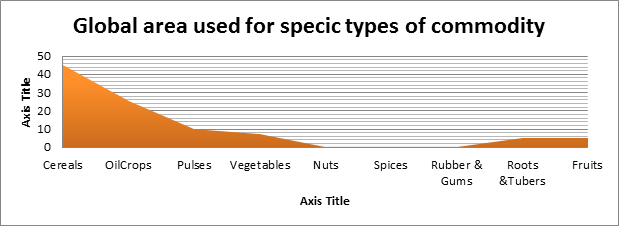
Undernourishment means that a person is not able to acquire enough food to meet the daily minimum dietary energy requirements, over a period of one year. FAO defines hunger as being synonymous with chronic undernourishment.
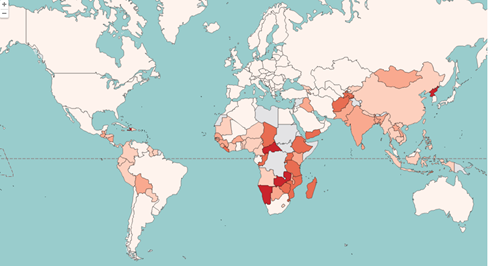
o 5% -> 14.9% - Moderately low
o <15% -> 24.9% - Moderately high
o 25% -> 34.9% - High
o 35% and over - Very high
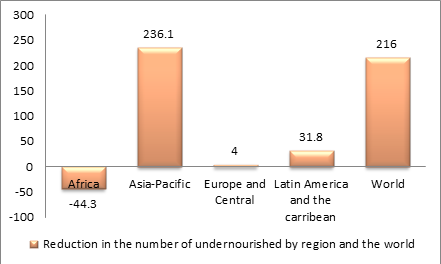
However, the region fell short of achieving the World Food Summit target. With 490 million people still suffering chronic hunger, the region is home to almost 62 percent of such people in the world. Eastern Asia and South-Eastern Asia have shown great success in reducing the number of hungry and have achieved the WFS target. Southern Asia, however, did not meet the WFS target. Although Eastern Asia and Southern Asia started with almost the same number of undernourished in 1990–92, the former has halved this number since then, while little has changed in the latter (Figure 4). Indeed, Southern Asia continues to be the sub region with the largest number of hungry people in the world. The number of hungry also increased in Oceania, although it is recognized that monitoring of progress by these countries is seriously hampered by data limitations. Overall, individual country performance in reducing the number of hungry differed widely. Only six of the 27 countries in the region achieved the WFS target of halving the number of undernourished. Two other countries almost reached the target, and another 14 made progress but did not achieve the target. Five countries experienced an increase in the number of undernourished.
Hunger Hotspot Analysis:
Projected changes in crop yield between 2000- 2030

The Millennium Development Goal (Target 1c)
The Millennium Development Goal hunger target measures the progress made by countries towards halving, between 1990-92 and 2015, the proportion of people suffering from undernourishment, or to bring this proportion below 5 percent.
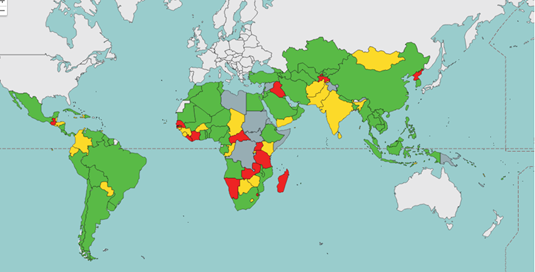
· Target 1C achieved
· Target 1C not achieved, with slow progress
· Target 1C not achieved, with lack of progress or deterioration
· Missing or insufficient values
Funds for Food Security:
AFRICAN AGRICULTURE FUND (AAF)
The fund targets all activities leading to the modernization of the agricultural sector on the African continent. It will invest across the value chain (from primary production to processing and tertiary services) giving priority to the following activities: cereals; livestock farming; dairy; fruit and vegetables; crop protection; logistics; fertilisers; seeds; edible oils; smallholders; and agricultural services. The fund is supposed to be around USD 300 million as a final target, where USD 30 million is dedicated to SMEs.
GLOBAL FOOD CRISIS RESPONSE PROGRAM (GFRP)
The target for funding is around USD 2 million. The programme provides support for grain stock management; improved use of market-based instruments to manage food prices; tax and trade policies; impact assessments; cash transfer programmes (CCTs, food stamps); school feeding; provision of food supplements; seed and fertilizer supply and market development; rehabilitation of small-scale irrigation; and improved access to finance and risk management tools.
GLOBAL AGRICULTURE FOOD SUPPLY PROGRAM (GAFSP)
The following focus areas are prioritised by the programme: high-yielding agricultural technologies; water management; land rights and land use; mobilization of rural finance to link farmers to the market; price and weather risk management; safety nets for food security; nutrition of vulnerable groups; and off-farm rural entrepreneurship. Technical assistance and capacity building are also eligible activities. The amount of fund pledged is around USD 1.1 billion in which 612 million has been received as of March 2012 by the countries mentioned in the figure below.
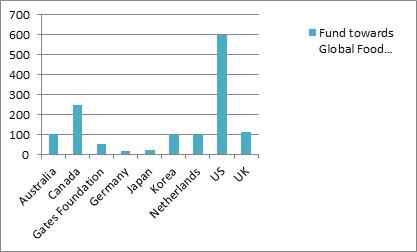
GLOBAL FOOD CRISIS RESPONSE PROGRAM (GFRP)
The programme provides support for grain stock management; improved use of market-based instruments to manage food prices; tax and trade policies; impact assessments; cash transfer programmes (CCTs, food stamps); school feeding; provision of food supplements; seed and fertilizer supply and market development; rehabilitation of small-scale irrigation; and improved access to finance and risk management tools.. the fund to be collected is around 2 USD Billion.
A project, co-directed by Wilfrid Laurier University researcher Jonathan Crush and the University of Cape Town’s African Centre for Cities director Edgar Pieterse, has been awarded $2.5 million in funding from the Social Sciences and Humanities Research Council of Canada and the International Development Research Centre through an International Partnerships for Sustainable Societies (IPaSS) grant.
Universities and Research Centres being funded by BBSRC Food Security:
![]() Babraham Institute, UK
Babraham Institute, UK
![]() University of Adelaide, Australia
University of Adelaide, Australia
![]() The Pirbright Institute, UK
The Pirbright Institute, UK
![]() Institute of Food Research, UK
Institute of Food Research, UK
![]() John Innes Centre, UK
John Innes Centre, UK
![]() Rothamsted Research, UK
Rothamsted Research, UK
![]() Institute of Biological, Environmental and Rural Sciences (IBERS), Aberystwyth University, UK
Institute of Biological, Environmental and Rural Sciences (IBERS), Aberystwyth University, UK
![]() Purdue University, USA
Purdue University, USA
![]() University of Birmingham,UK
University of Birmingham,UK
![]() University of Cambridge,UK
University of Cambridge,UK
![]() The University of Nottingham,UK
The University of Nottingham,UK
Major industries involved with Food Security:
- Cargill
- Dai
- Dupont Food Security
- The Aspen
- GRM future group company
Associations Involved with Food Security Worldwide:
Ø Ashoka Innovators for the Public (United States/International) – Ashoka has been transforming the landscape of social innovation since 1980. It is encouraging fundamental transformation of the food chain to full nutrition with an initiative linking human wellbeing, agriculture, and the environment. Australian International Food Security Centre (AIFSC) (Australia) – The AIFSC is a non-profit organization that works to promote agricultural innovation and attract investment to agricultural development projects. Aiming to build capacity for farming initiatives worldwide, it focuses on achieving specific goals like improving nutrition, connecting researchers with industry, and enhancing supply chain systems to allow farmers to bring their products to market.
Ø Barilla Center for Food & Nutrition (BCFN) (Italy) – The Barilla Center for Food & Nutrition works to promote science and research for combating hunger and malnutrition worldwide. Using knowledge gleaned from research projects around the world, BCFN seeks to take innovative ideas for tackling food insecurity and translate them into effective policy recommendations for governments around the world.
Ø Bioversity International (International) – Bioversity International is a research and development organization aimed at supporting smallholder farmers in the developing world through sustainable agriculture and conservation.
Ø The Center for Studies and Development of Cambodian Agriculture (CEDAC) (Cambodia) - In partnership with Farmer and Nature Net (FNN), CEDAC has worked to promote the System of Rice Intensification (SRI), which has been shown to increase yields and improve soil fertility while reducing the use of chemicals and maintaining local ownership of seeds. CEDAC supports several other agricultural innovations and techniques including Ecological Chicken Raising (ECR), pig raising, home gardening, aquaculture, composting, and multi-purpose farming.
Ø Chicago Council on Global Affairs Global Agricultural Development Initiative (United States/International) - The Global Agricultural Development Initiative seeks to inform the development of U.S. policy on global agricultural development and food security by raising awareness and providing resources, information, and policy analysis to the U.S. Administration, Congress, and interested experts and organizations.
Ø Christensen Fund (United States) – The Christensen Fund is a philanthropic organization dedicated to promoting biological and cultural diversity, making grants to organizations that work in fields like conservation science, visual arts, and education. The Fund is particularly noted for its work on agrobiodiversity and food sovereignty, in which it provides resources for indigenous and local farming communities to protect and enhance local food systems.
Ø EARTH University (Costa Rica) – EARTH University is an international non-profit undergraduate institution based in Costa Rica focused on agricultural sciences and natural resource management. EARTH’s mission is to “prepare leaders with ethical values to contribute to the sustainable development of the tropics and to construct a prosperous and just society.”
Ø Feeding the 5000 (United Kingdom/International) – Tristram Stuart’s initiative is organizing the world to prevent "wonky" fruits, vegetables, and other food from being wasted. Feeding the 5000 encourages farmers to participate in the “gleaning movement” – where volunteers collect unattractive produce that would otherwise be wasted for consumption.
Ø World Vegetable Center (AVRDC) (Taiwan/International) – AVRDC is an international non-profit organization dedicated to reducing poverty and malnutrition in the developing world by increasing agricultural production and access to a variety of vegetables, providing essential micronutrients for populations in need. The Center works with both private and public sector partners to strike an effective balance between necessary research for new technologies and development to employ those technologies effectively.
Ø United Nations Food and Agriculture Organization (FAO) (International) – The Food and Agriculture Organization is the United Nations’ international agency overseeing global food security and agriculture. FAO’s main activities include knowledge-sharing among member nations, making information about food and agriculture available for all people, supporting policies to reduce malnutrition and other illnesses worldwide.
Ø WinRock (United States/International) – WinRock works with marginalized people all over the world to provide them with the skills and resources they need to bring themselves out of poverty. WinRock’s projects include, among others, empowering women and youth, and teaching environmentally responsible farming methods.
Ø World Vegetable Center (AVRDC) (Taiwan/International) – AVRDC is an international non-profit organization dedicated to reducing poverty and malnutrition in the developing world by increasing agricultural production and access to a variety of vegetables, providing essential micronutrients for populations in need. The Center works with both private and public sector partners to strike an effective balance between necessary research for new technologies and development to employ those technologies effectively.
Conference Highlights
- Aquaculture in Food Security
- Global Food Security
- Sustainable Food Production Systems
- Environmental Change and Food Security in China
- Hybridization and Its Effect
- Urbanization and Food Value Chains
- Consumer Behaviour and Nutritional Security
- Trade Liberalization
- Biofuels :Importance in Food Security
- Genetically Modified Crops : Solution to Global Food Security
- Science,Sociology and Economics
- Entrepreneurs Investment Meet
To share your views and research, please click here to register for the Conference.
To Collaborate Scientific Professionals around the World
| Conference Date | September 05-07, 2016 | ||
| Sponsors & Exhibitors |
|
||
| Speaker Opportunity Closed | Day 1 | Day 2 | Day 3 |
| Poster Opportunity Closed | Click Here to View | ||
Useful Links
Special Issues
All accepted abstracts will be published in respective Our International Journals.
- Journal of Food Processing & Technology
- Journal of Nutrition & Food Sciences
- Journal of Food and Nutritional Disorders
Abstracts will be provided with Digital Object Identifier by








